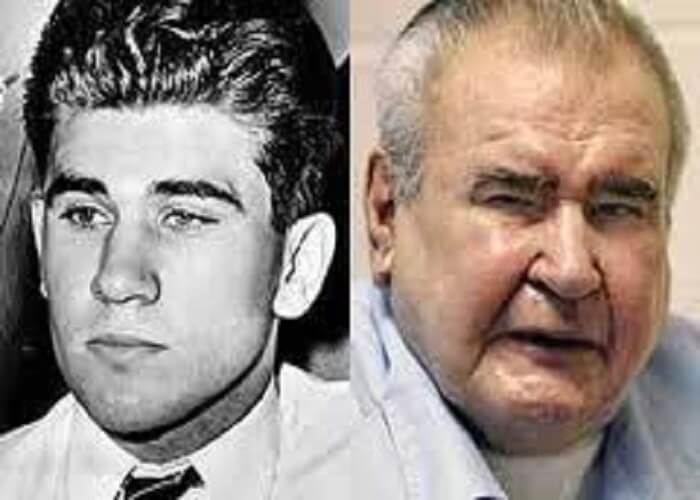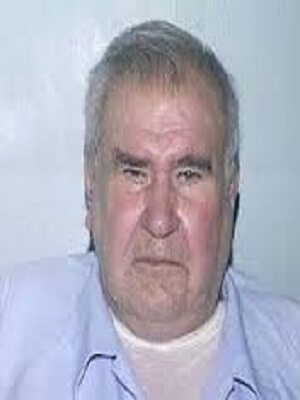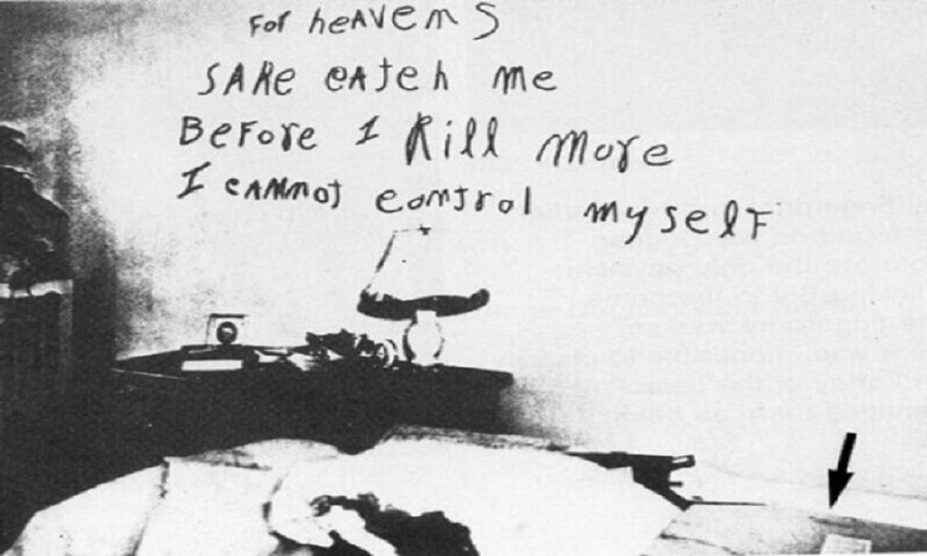“For heavens sake catch me before I kill more, I cannot control myself.”-The Lipstick Killer
After the horrific murder of a 6-year-old girl, William Heirens was caught breaking into an apartment not far from where she was abducted. His fingerprint was matched to evidence found on the ransom note and after a month in custody, he confessed to all three murders.
It was an open-and-shut case. A murderer was caught and stopped from taking more lives and the police, press, and people of Chicago felt satisfied. William Heirens accepted a plea bargain to avoid the death penalty and he spent 65 years behind bars before his death in March 2012 aged 83.
But this is not an open and shut case, upon further investigation, there are factors which in today’s world would have made his conviction unsafe and the credibility of his confession be questioned.
The Lipstick Killer Murders
In 1945, 43-year-old Josephine Ross and 33-year-old Frances Brown had been killed inside their homes. Both were found with fatal stab wounds, Frances Brown had also been shot. These were brutal and violent murders with similarities leading police to quickly link them to the same killer.
In the apartment of Frances Brown, the now famous message was scrawled in the victim’s lipstick above her bed. The media went wild; there was a multiple killer on the loose, targeting lone women in their own homes. The message left for the police was the headline they needed. It was a huge story, the public was frightened and the pressure was on.
In 1946, on the 7th of January, 6-year-old Suzanne Degnan was abducted from her bedroom. A ransom note was left behind demanding $20’000 for the safe return of the little girl with instructions not to inform the authorities. Hours later the dismembered body of Suzanne Degnan was found in the sewer drains of Chicago near her home.

The Arrest of William Heirens
Born and raised in Chicago, William Heirens was a quiet child who spent much time alone. In his early teens, he began burgling homes usually looking for apartments that did not lock their doors.
He would check no one was home, sneak in and steal anything left lying around of value, hunting for wallets and purses containing cash.
Despite a number of arrests including one arrest for possession of a stolen handgun and time spent at correctional schools, Heirens seemed hooked on burglary and always returned to his thieving ways whenever he could.
At the time of his arrest, he was a Chicago University student studying electrical engineering.
On 26th June 1946, William Heirens was robbing an apartment when he was spotted by another resident who called the police.
When he realized they were onto him he ran. Police fired at Heirens after he pulled out a gun but it was a hit over the head with a nearby flower pot which rendered him unconscious.
He was arrested and taken to Cook County Jail in Illinois. His fingerprints were taken and by then all were talking that he was the main suspect in the Lipstick Killer case. No attorney or legal representation was called and Heirens, throughout all of this, was still unconscious. Within days his prints had been matched to fingerprint evidence found on the ransom note left at the scene of Suzanne Degnan’s abduction.
His name was released to the media and as far as Chicago was concerned the Lipstick Killer had been caught. The now famous FBI profiler Robert Ressler was a 6-year-old boy at the time and claims this was the case that got him interested in tracking and understanding serial killers.
Heirens refused to confess and was injected with ‘truth serum’ sodium pentothal and given a spinal tap without anesthetic to see if he was faking his delirium. Heirens claims he was held in a room with a single light bulb, tied down to the bed while recovering from his head injuries while he was questioned repeatedly.
“I was strapped down to a bed and they questioned me. But I decided then not to answer the questions if I didn’t have to so I wasn’t very cooperative that way.” –William Heirens
In 1946 the Miranda warning didn’t exist and Heirens was subjected to pressure and abuse by intimating and forceful police. He was terrified, he continued to say he didn’t do it and the pressure to confess remained.
The Chicago Media on the Lipstick Killer Case
Heirens claims an article in a Chicago newspaper, the Chicago Tribune, was what made him lose hope. With the headline: “The Heirens Story! How He Killed Suzanne Degnan and 2 Women”, the article claimed William Heirens had confessed and provided full detail of the confession and the murders.
Heirens had in fact not confessed and the story was a fabrication by the reporter George Wright in order to sell more papers. Other news articles fed off this one with paper after paper printing their own versions. Heirens was a monster, an evil individual who has been caught and taken off the streets and now he should be executed for his crimes.
Thinking he had lost and in an attempt to avoid the death penalty he confessed, using the information he had read in the newspapers and what the police had already told him about the crimes. This meant life behind bars over a trial and the possibility of the death sentence which he was sure he would get.
A Confession To Murder
William Heirens went straight to prison and there he would spend the next 65 years. In 1954 the Illinois Supreme Court did recognize there may have been some violations of his constitutional rights, but they did not affect the outcome of the case and therefore a new trial was denied.
He repeated the same story over and over again, that he did not commit these crimes and he was not the Lipstick Killer. He had confessed because he felt he had no choice. A prisoner convicted of a heinous crime who protests their innocence can spend year upon year behind bars with no one listening to their story.
In the case of William Heirens, the so-called Lipstick Killer of Chicago, it was Dolores Kennedy, the daughter of a defense attorney and a legal representative herself who came to his aid. She realized that the news reports of the time were very inaccurate and the actual events of 1946 had not been told. She began to write a book about the case and came to believe he was truly innocent. Her book was published in 1991 called “His Day In Court” and claimed he was a scapegoat and not the Lipstick Killer. His confession to the crimes was the main barrier in trying to get anyone to listen to the facts of the case and review the outcome.
A similar set of circumstances eventually led to the release of Edward Lee Elmore in South Carolina in 2012. Although he never confessed to the murder he was charged with it took over 20 years for newly qualified lawyer Diana Holt to prove his innocence.
Cases of false confession do happen, often involving a youngster under pressure and feeling they need to tell police what they want to hear. The case of Stephen Downing echoes that of William Heirens. In 1974 in England, 17-year-old Stephen Downing found the body of 32-year-old Wendy Sewell in the cemetery where he worked. He found himself arrested for murder and being told repeatedly he had committed the crime and he just needed to admit it. Thinking if he confessed they would leave him alone and find the real killer, Downing said he had committed the murder and he was given an indefinite sentence with a minimum of 10 years in prison.
He spent 27 years in prison protesting his innocence until a local reporter got involved in the case and finally unearthed the evidence and flawed investigation which saw him imprisoned as an innocent man. Stephen Downing was finally released in 2002 after his conviction was overturned in a case that is now considered one of the biggest miscarriages of justice in the UK.
“When you get someone interested in the case and willing to stick with it you’ve got something, and I’m darn lucky to have Dolores.” –William Heirens
The Fight To Free William Heirens
Dolores Kennedy was determined to fight for the innocence of William Heirens and get him released from jail. She hired a defense attorney, Jed Stone, to re-examine the case and the evidence which had convinced the nation that William Heirens was the Lipstick Killer.
The fingerprint on the ransom note: Suspicions on the credibility of this evidence have been raised. Initially, police found no prints and sent the note to the FBI whose advanced techniques found two prints on the front of the ransom note.

Upon retesting the note with today’s developed methodology, a forensic examiner has claimed the fingerprint in question was highly unusual, and a full and obvious print such as this is very rarely found at a crime scene. They concluded it is a strong possibility that print was left at the scene on purpose, transferred from the fingerprints police had on file for William Heirens to manufacture evidence he was at the scene of the crime.
Handwriting analysis: In 1946 samples of William Heirens handwriting were said to have been compared to both the ransom note and the scrawled message left on the wall with a clear match found.
Experts hired by Heirens however disagree and say the handwriting is not a match or even a close match and it should never have been submitted as evidence.
The message on the wall: Possibly the most disturbing aspect of this case is the revelation by a retired Chicago reporter that the killer did not leave the now infamous message on the wall of Frances Brown’s home. He claims it was a reporter who wrote the message, who arrived at the crime scene before police and thought it would make the case more interesting and newsworthy.
This would support the claim that the handwriting is not a match for William Heirens. Moreover, if this is true, it puts an entirely different slant on the case of the Lipstick Killer of 1946. While such evidence and findings were building in an attempt to secure a retrial for William Heirens it came too late. By this time William Heirens was an old man. He had served 65 years in prison and was now suffering from health problems including diabetes. He was found dead in his cell on 6th March 2012.
William Heirens applied for release over 30 times during those years never wavering from his story of innocence. Born in 1928 and imprisoned for life in 1946, William Heirens became the longest-serving prisoner in the United States prison system. With evidence that now suggests he was an innocent man, this is a horrifying realization.
Related Books:
- Mindhunter: Inside the FBI’s Elite Serial Crime Unit “Douglas invented and established the practice of criminal profiling. With the fierce page-turning power of a bestselling novel, yet terrifyingly true, Mindhunter is a true crime classic.
- Dark Dreams: A Legendary FBI Profiler Examines Homicide and the Criminal Mind “Hazelwood has helped track down some of the most violent and well known criminals in modern history. The cases he describes are as shocking as they are perplexing; their resolutions are as fascinating as they are innovative.”
- Serial Killers: The Method and Madness of Monsters Vronsky not only offers sound theories on what makes a serial killer but also provides concrete suggestions on how to survive an encounter with one.




Congrat super
In the years since, Wm. Heirens innocence had already been proven; he had nothing to do with Susan Degnan’s murder and police knew it from the start. This occurred during the years when cops could get away with beating confessions out of suspects, which is what happened to Wm. Heirens. Not long before he died, a retired Chicago cop privately said that Heirens got railroaded because the city was demanding an arrest in the little girl’s murder; the pressure to apprehend someone was tremendous in 1946. The heat died down somewhat when Heirens got hauled into the police station, and Chicagoans felt justice was served when he was sentenced to life without parole. It was all a lie. Fingerprints supposedly left on a ransom note matched Heirens, but never officially verified. Heirens own handwriting didn’t even come close to that of whoever wrote the ransom note. But the public never heard that part. All the public heard was whatever the police WANTED them to hear. In the end, 2 innocent lives had been taken, whether the city of Chicago wants to admit it or not.
Heirens was beyond innocent. Every piece of evidence was made up. They were fine with putting an innocent man behind bars and to let two psycho killers roam free. The two women and the child are not related